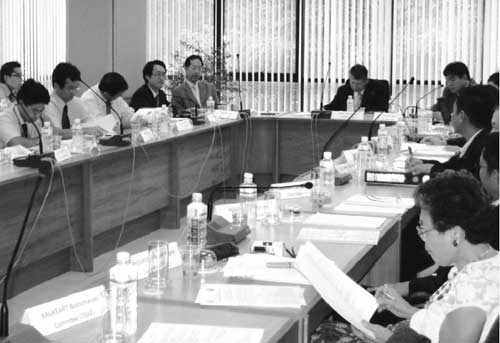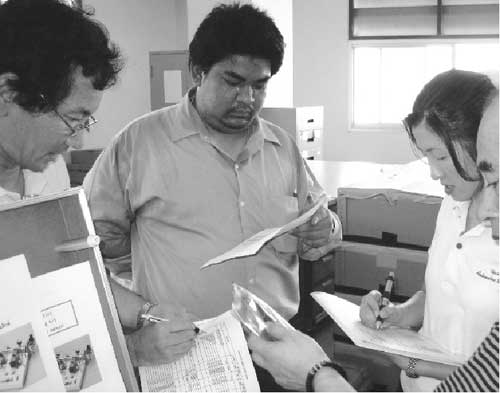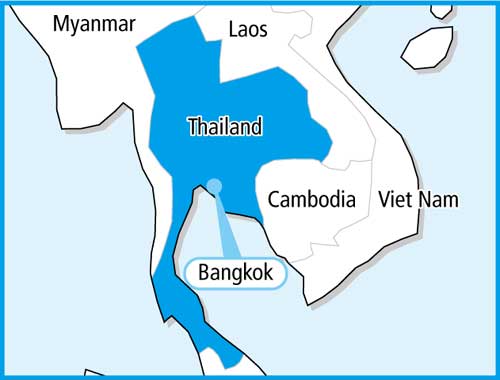Japan's Official Development Assistance White Paper 2008
—A JICA Expert Playing a Crucial Role in Public-Private Cooperation—
"Let's make Thailand Asia's Detroit." With strength and enthusiasm, the Government of Thailand is invigorating the country's auto industry. Thailand produced 1.29 million automobiles in 2007, making it the world's 15th largest automobile manufacturer. And by 2011, Thailand endeavors to rank among the world's top 10 by raising their annual unit production to two million. Thailand has also embarked on the production of an environmentally-friendly "eco-car." But soon after beginning, problems arose such as an insufficient number of local engineers and human resource development issues.

The steering committee (JICA expert Mr. Kameya is second from the left from the viewer's perspective)
During discussions held in 1999 on the development of Thailand as an auto production base, industry support through human resource development rose to the forefront as the most urgent issue to address. Accordingly, various meetings were held among the Thai Ministry of Industry, the Federation of Thai Industries (FTI), the Japan External Trade Organization (JETRO), the Human Resource Development Committee of the Automobile Division of the Japanese Chamber of Commerce, Bangkok (JCCB) — with principal members including Denso, Honda, Nissan, and Toyota in an alphabetical order — and Japanese and Thai private sector companies. Subsequently, a memorandum of understanding (MOU) on the Automotive Human Resource Development Project was concluded between JETRO, JCCB, the Thai Ministry of Industry, and the FTI. Based on this, public-private cooperation for human resource development has begun with the participation of the Association for Overseas Technical Scholarship (AOTS) from Japan.
Currently, the Government of Thailand is tasked with the formation of a human resource development system that integrates the skills required in the workplace with systems such as proficiency testing. Thailand requested the assistance of the Government of Japan for technical cooperation to establish the human resource development system. This request initiated the Automotive Human Resource Development Project (AHRDP), which began in December 2006 for public-private cooperation in Japan and Thailand utilizing Japan's Official Development Assistance (ODA). This project was unique in that ODA was used with the backing of the Government of Japan, the private sector, and their respective counterparts in a developing country.
Mr. Toshiro Kameya is a JICA expert who is an advisor on this project. Having served at the Ministry of International Trade and Industry-now the Ministry of Economy, Trade and Industry-after working in the design division of an automobile manufacturer, Mr. Kameya was deemed to be the right person to be dispatched as an advisor.
Mr. Kameya advised the Government of Thailand on policies and qualification systems so that it could, with the help of local instructors with previous experience working with Japanese companies, provide people in supporting industries with training in a sustainable manner. Decision-making authority is held by the steering committee of the project. However, those attending the meeting were not particularly outspoken, so the discussions were not very lively. It occurred to Mr. Kameya that in order to sincerely understand the Thai people's mentality, he must expand his experiences outside of the meetings, so he started attending various gatherings of local companies and visiting parts plants in Thailand. He would then present the information he obtained to the steering committee members as well as the ideas he learned from the Thais on these occasions for further discussion. Very frequently, the Thai people told Mr. Kameya how much they appreciate his efforts by saying "I'm glad to hear you said that."
The Thai and Japanese seem to have different views on human resource development. For example, Mr. Kameya once took officers of the Thai Ministry of Industry and parts manufacturers to a plant in Japan. Mr. Kameya recalls that the Thais, after talking with the Japanese workers there, were so eager to know why the Japanese people do not just switch jobs when they are given the opportunity to improve their skills by human resource development projects. His comprehensive understanding of the differences between the Japanese and Thai ways of thinking as shown above allows Mr. Kameya to answer questions from the local people insightfully, affirming that he is an adequate advisor for the Thai people.
Mr. Kameya is confident that the Thai people will increasingly play a larger role, as public-private cooperation between Japan and Thailand progress, in their dreaming of becoming Asia's Detroit.

Mr. Kameya checks the condition of equipment for training



 Next Page
Next Page